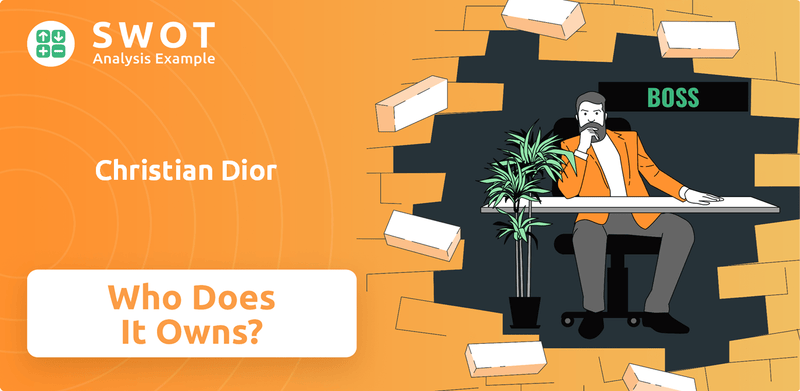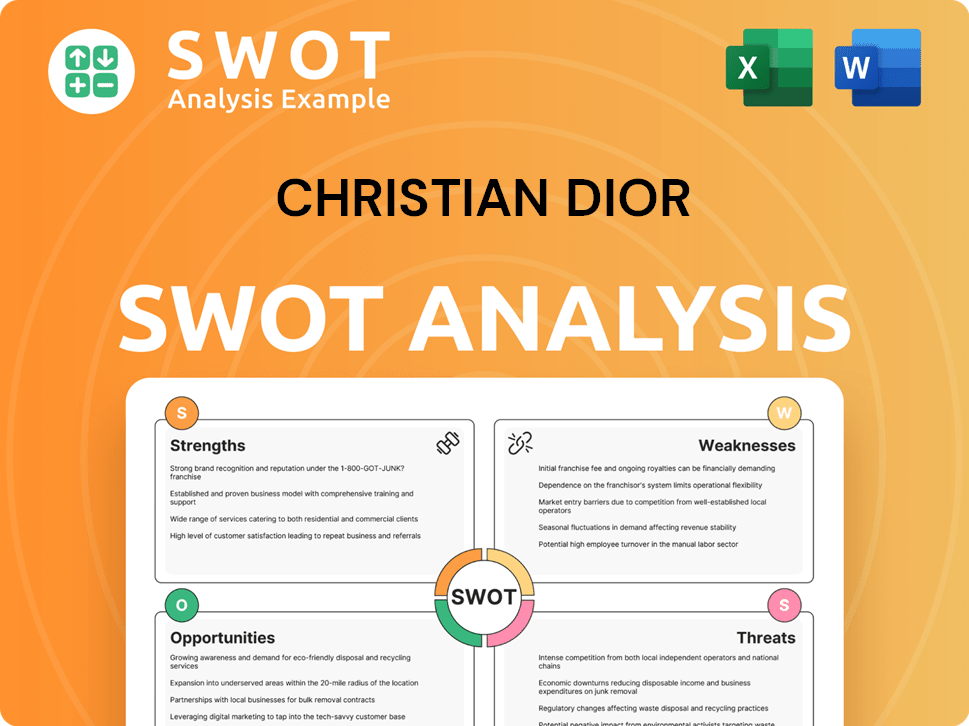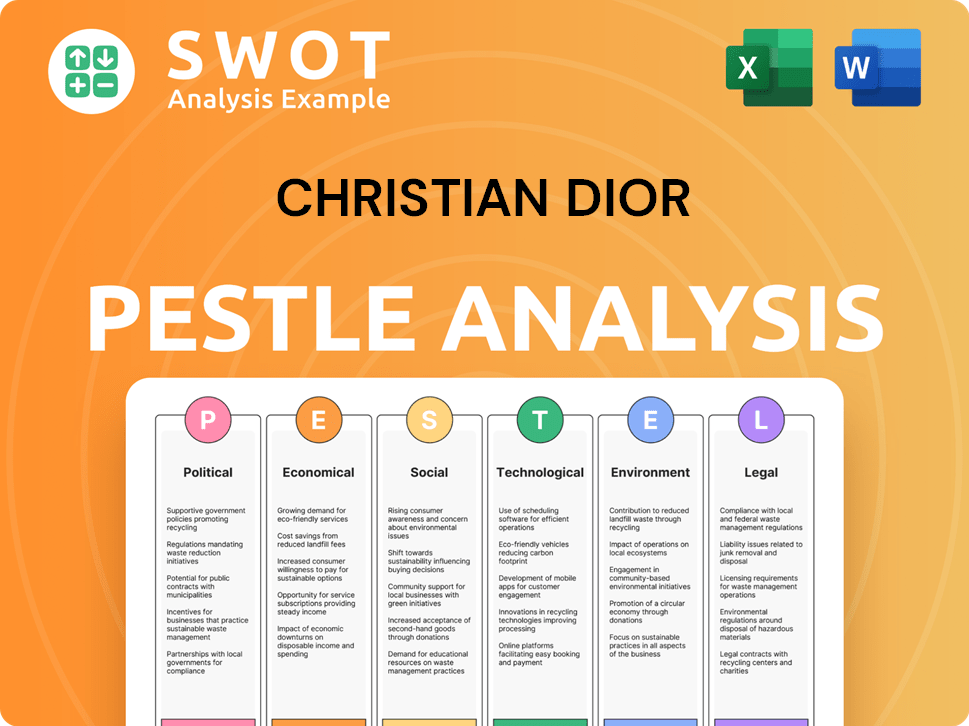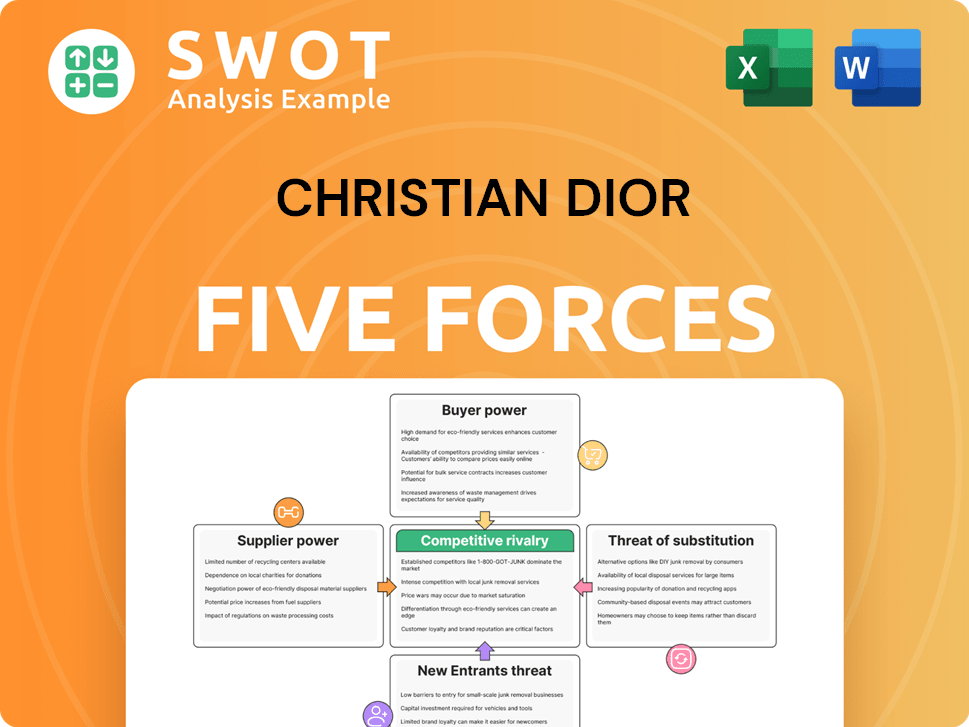Christian Dior Bundle
Who Really Owns Christian Dior?
Ever wondered who pulls the strings at one of the world's most iconic fashion houses? Understanding Christian Dior SWOT Analysis is crucial to grasping its strategic moves. The ownership structure of Christian Dior dictates its future, influencing everything from product lines to global expansion. Knowing the key players is the first step to understanding the luxury brand's complex world.

The story of Dior ownership is intertwined with the rise of LVMH and the vision of Bernard Arnault. Exploring the Dior parent company reveals a fascinating journey through the luxury market, from its founding by Christian Dior to its current status. This exploration will uncover who controls Dior, its market share, and the key individuals shaping its future, offering valuable insights for anyone interested in luxury brands and the fashion house's financial information.
Who Founded Christian Dior?
The story of Christian Dior began in 1946, when Christian Dior founded the company. This marked the start of a fashion revolution, backed by the financial support of Marcel Boussac.
Boussac, a textile magnate, provided the initial capital, setting the stage for the brand's rise. This partnership was crucial in bringing Dior's vision to life and establishing the iconic fashion house.
The early ownership structure reflected a blend of creative and financial control. While specific equity splits are not publicly available in percentages, Boussac held a controlling interest. This ensured Dior had the resources to flourish.
Christian Dior founded the company in 1946. Marcel Boussac, a wealthy textile magnate, provided the initial capital.
Boussac invested 60 million French francs. This investment was crucial for launching the brand.
Boussac held a controlling interest. Dior, as the creative force, held a significant stake.
The partnership aimed to secure Dior’s artistic autonomy. Boussac managed the business operations.
Dior's 'New Look' quickly gained international acclaim. This success propelled the brand's rapid expansion.
The founding team's vision established the brand's iconic status. This early structure allowed for rapid growth.
The early ownership of Christian Dior was a strategic alliance, with Marcel Boussac providing the financial backing and Christian Dior leading the creative vision. This setup allowed the fashion house to quickly establish itself as one of the leading luxury brands globally. While the exact percentages of ownership at the start are not fully detailed, it's clear that Boussac's financial support was critical. This partnership, focusing on both financial and creative aspects, set the stage for the company's future growth and influence in the fashion industry. As of 2024, the parent company, LVMH, continues to oversee the brand, reflecting a long-term strategy of maintaining Dior's ownership and market position. In 2023, LVMH reported revenue of €86.2 billion, with fashion and leather goods, including Dior, being a major contributor. The brand's continued success is a testament to its strong foundation and strategic partnerships.
Christian Dior SWOT Analysis
- Complete SWOT Breakdown
- Fully Customizable
- Editable in Excel & Word
- Professional Formatting
- Investor-Ready Format

How Has Christian Dior’s Ownership Changed Over Time?
The evolution of Christian Dior's ownership has been marked by pivotal shifts. A key moment was Bernard Arnault's 1984 acquisition of the Boussac group, which included Christian Dior. This move, executed through Financière Agache, gave Arnault control of the fashion house. Later, in 2017, LVMH Moët Hennessy Louis Vuitton acquired Christian Dior Couture from Christian Dior SE for €6.5 billion, streamlining the Dior fashion and leather goods operations under LVMH.
Today, Christian Dior SE primarily acts as a holding company. Its main asset is its significant stake in LVMH. As of late 2024, the Arnault family, through Financière Agache, owns about 48.6% of the share capital and 63.9% of the voting rights in LVMH. This structure places the Arnault family in a position of ultimate control over Christian Dior SE through their dominant position in LVMH. The remaining shares of Christian Dior SE are held by public shareholders, mainly institutional investors and mutual funds. This ownership setup provides a centralized approach to strategy and governance across the extensive LVMH luxury empire.
The Arnault family, through Financière Agache, controls Christian Dior SE.
- In late 2024, the Arnault family holds approximately 48.6% of the share capital and 63.9% of the voting rights in LVMH.
- LVMH acquired Christian Dior Couture in 2017.
- Christian Dior SE is a holding company.
Christian Dior PESTLE Analysis
- Covers All 6 PESTLE Categories
- No Research Needed – Save Hours of Work
- Built by Experts, Trusted by Consultants
- Instant Download, Ready to Use
- 100% Editable, Fully Customizable

Who Sits on Christian Dior’s Board?
The current board of directors of Christian Dior SE is structured to reflect its role as a holding company, with significant influence from LVMH. The board's composition is closely linked to the Arnault family's control, who also hold key positions within LVMH. Bernard Arnault, as Chairman and CEO of LVMH, exerts considerable influence over both entities, solidifying the family's grip on the company. This structure ensures alignment between the parent company and its major subsidiary, reflecting the strategic direction set by LVMH.
The governance of Christian Dior SE is inherently tied to the Arnault family's substantial ownership. While the voting structure is primarily one-share-one-vote, the family's concentrated ownership through Financière Agache grants them significant control. This structure has remained stable, with no major changes reported recently. The Arnault family's dominant position minimizes the likelihood of external challenges to decision-making, ensuring a centralized approach to corporate strategy and operations. This is a critical factor in understanding who controls Dior.
| Key Aspect | Details | Impact |
|---|---|---|
| Board Composition | Reflects holding company structure; closely tied to LVMH leadership. | Ensures alignment with LVMH's strategic direction. |
| Voting Structure | One-share-one-vote, but with concentrated Arnault family ownership. | Provides the Arnault family with outsized control. |
| Ownership Control | Arnault family through Financière Agache. | Minimizes external challenges; centralizes decision-making. |
The Arnault family's control over Christian Dior SE is a critical aspect of understanding the luxury brand's governance. As of late 2024, the Arnault family holds a significant majority of the voting rights in LVMH, which directly translates to their control over Christian Dior SE. This ownership structure has remained consistent, with no widely reported proxy battles or activist investor campaigns specifically targeting Christian Dior SE in recent years. This centralized control is a key factor in the company's strategic stability. For more insights into the brand, you can explore the history of Christian Dior.
The Arnault family, through LVMH and Financière Agache, maintains significant control over Christian Dior.
- Bernard Arnault's influence is central to the company's strategic direction.
- The voting structure reinforces the family's dominant position.
- This strong ownership structure minimizes external challenges.
- The Arnault family's control is a key factor in Dior's stability.
Christian Dior Business Model Canvas
- Complete 9-Block Business Model Canvas
- Effortlessly Communicate Your Business Strategy
- Investor-Ready BMC Format
- 100% Editable and Customizable
- Clear and Structured Layout

What Recent Changes Have Shaped Christian Dior’s Ownership Landscape?
Over the past few years, the ownership structure of Christian Dior SE has remained remarkably consistent. The most significant change was the 2017 acquisition of Christian Dior Couture by LVMH, which solidified the current holding company structure. This means that the Arnault family, through Christian Dior SE, maintains significant control over LVMH, the parent company of many luxury brands, including the fashion house.
Recent developments have focused on the performance of LVMH, which directly benefits Christian Dior SE. For instance, LVMH's revenue growth and profitability in 2024, demonstrate the strength of the luxury market and the strategic success of LVMH. The Arnault family's continued strategic investments and leadership within LVMH underscore their enduring commitment to and control over Christian Dior SE. You can also read about the Growth Strategy of Christian Dior.
| Metric | 2024 | 2023 |
|---|---|---|
| LVMH Revenue (€ billions) | ~86 | ~79.2 |
| LVMH Profit from Recurring Operations (€ billions) | ~22.8 | ~22.8 |
| Christian Dior SE Market Capitalization (€ billions) | ~150 | ~140 |
The Arnault family's continued strategic investments and leadership within LVMH underscore their enduring commitment to and control over Christian Dior SE. There have been no public statements about planned succession or potential privatization/public listing for Christian Dior SE itself, as its current structure as a holding company for the Arnault family’s stake in LVMH appears to be a long-term strategy.
Christian Dior is primarily owned by Christian Dior SE, which is controlled by the Arnault family. This family also controls LVMH, the parent company of Dior and many other luxury brands.
The structure is designed so that Christian Dior SE owns a significant stake in LVMH. This arrangement allows the Arnault family to maintain control over the luxury group.
LVMH's financial performance directly impacts Christian Dior SE. Strong revenue and profitability at LVMH translate into benefits for Christian Dior SE.
The current ownership structure seems stable. No plans for major changes have been announced, suggesting the Arnault family's long-term commitment.
Christian Dior Porter's Five Forces Analysis
- Covers All 5 Competitive Forces in Detail
- Structured for Consultants, Students, and Founders
- 100% Editable in Microsoft Word & Excel
- Instant Digital Download – Use Immediately
- Compatible with Mac & PC – Fully Unlocked

Related Blogs
- What are Mission Vision & Core Values of Christian Dior Company?
- What is Competitive Landscape of Christian Dior Company?
- What is Growth Strategy and Future Prospects of Christian Dior Company?
- How Does Christian Dior Company Work?
- What is Sales and Marketing Strategy of Christian Dior Company?
- What is Brief History of Christian Dior Company?
- What is Customer Demographics and Target Market of Christian Dior Company?
Disclaimer
All information, articles, and product details provided on this website are for general informational and educational purposes only. We do not claim any ownership over, nor do we intend to infringe upon, any trademarks, copyrights, logos, brand names, or other intellectual property mentioned or depicted on this site. Such intellectual property remains the property of its respective owners, and any references here are made solely for identification or informational purposes, without implying any affiliation, endorsement, or partnership.
We make no representations or warranties, express or implied, regarding the accuracy, completeness, or suitability of any content or products presented. Nothing on this website should be construed as legal, tax, investment, financial, medical, or other professional advice. In addition, no part of this site—including articles or product references—constitutes a solicitation, recommendation, endorsement, advertisement, or offer to buy or sell any securities, franchises, or other financial instruments, particularly in jurisdictions where such activity would be unlawful.
All content is of a general nature and may not address the specific circumstances of any individual or entity. It is not a substitute for professional advice or services. Any actions you take based on the information provided here are strictly at your own risk. You accept full responsibility for any decisions or outcomes arising from your use of this website and agree to release us from any liability in connection with your use of, or reliance upon, the content or products found herein.